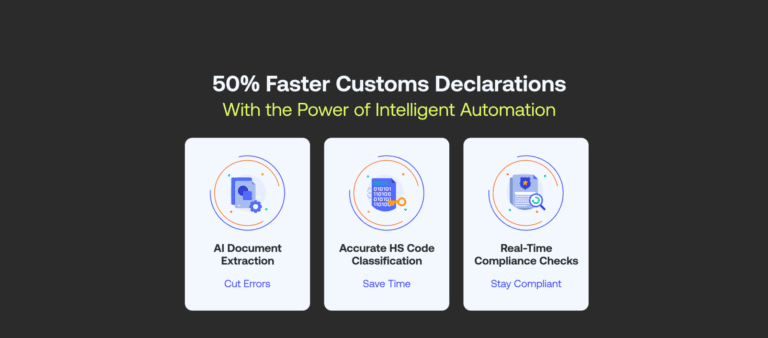Sort your ICS2 declarations in 90 seconds with AI
Achieve 50% Faster Customs Declarations: The Power of Intelligent Automation
- John Hall
- Customs Specialist at iCustoms.ai
Imagine a logistics team completes customs declarations at midnight, but a single typo or misclassified tariff code causes a multi-day delay at the border.
The cost? Warehouse fees, a frustrated team, and lost trust. But what if that entire step could take half the time?
However, in the modern era, AI is altering the whole process.
Recent AI‑powered platforms are helping businesses cut customs declaration times by up to 50%, turning unmanageable paperwork into a streamlined digital task.
From AI‑driven document extraction to automated HS classification and rule‑based compliance checks, smart automation is transforming trade operations worldwide.
This blog post explores how automation helps businesses achieve 50% faster customs clearance.
Why is the traditional customs declaration so slow?
Despite the advanced technology, many import/export businesses still follow the old, manual way of handling customs declarations. It’s slow, disorganised, and prone to errors.
Here’s what is going wrong with these methods:
More manual tasks = more mistakes
There are piles of paperwork, including packing lists, certificates, and invoices. It consumes a lot of time for teams to manually enter all of this data, line by line. Additionally, it is easy to make mistakes, such as using an incorrect HS code or missing important fields. These errors may cause serious problems, so they are not minor ones.
Trade regulations are always changing
Customs laws are constantly changing. A new tariff appears one day, and then a new requirement appears the next. Teams struggle to keep track of everything, and if they miss even the smallest detail, they risk noncompliance or even legal issues.
Data is all over the place
Crucial information is frequently dispersed over multiple spreadsheets, emails, and systems that are incompatible with one another. Teams thus waste hours trying to find the correct information. It’s difficult to react quickly to issues or make decisions without a clear, real-time vision.
System Integration: Syncs data from ERPs, freight platforms, and government portals in real time.
What is intelligent automation?
Intelligent automation is the combination of artificial intelligence (AI), machine learning, and optical character recognition (OCR) that makes it possible to complete monotonous customs procedures more quickly, intelligently, and accurately.
Imagine providing your customs staff with a digital assistant that is up-to-date on the most recent customs regulations, never sleeps, and never makes errors.
Key features:
- AI document extraction: Automatically scans and extracts fields from scanned documents, emails, and PDFs.
- HS code classification: Provides accurate commodity codes based on product descriptions and historical data.
- Real-time compliance checks: Identifies discrepancies or missing information prior to customs submission.
- System integration: Real-time data synchronisation across government portals, freight platforms, and ERPs.
How automation achieves 50% faster declarations
Data extraction from any format automatically
Teams must gather information from invoices, packing lists, business documents, and certificates in a standard customs procedure. These documents are commonly in a variety of inconsistent formats, such as scanned copies, PDFs, or even handwritten papers.
No matter the layout or language, automation systems can quickly extract pertinent data from these files using AI-powered OCR (Optical Character Recognition) and intelligent document processing (IDP).
- Before automation: Data entry for a multi-line invoice may take a staff worker 30 to 45 minutes.
- With automation: AI retrieves and validates the data in less than two minutes, eliminating the need for human re-entry.
In addition to saving time, this guarantees accuracy in all fields, including declared value and product description.
Quicker and accurate classification of HS codes
It’s crucial to assign Harmonised System (HS) codes correctly. A single inaccurate code can lead to delays, fines, or noncompliance.
To locate the correct match, staff members typically search through internal guidelines and tariff databases, which is really time-consuming and error-prone.
This is made simpler by AI-based classification engines:
After reading product descriptions and contrasting them with past data, they suggest the most accurate HS code. Additionally, a lot of platforms gain knowledge over time, increasing their precision with every shipment they handle.
Built-in validation and compliance engines
To guarantee compliance, manual declaration procedures frequently rely on scattered checklists. This raises the possibility of errors, especially for complex shipments involving multiple countries, sensitive goods, or frequent regulatory updates.
Automation systems have built-in real-time compliance engines that automatically verify:
- Whether the appropriate incoterms are chosen
- Whether export certifications or licenses are necessary
- If product quantities and values are consistent across documents
- Dual-use goods or embargoed countries are marked
The system highlights anything missing or incorrect before submission, lowering the possibility of rework and customs rejections.
System integration eliminates double work
The logistics teams enter the same data into various platforms, including ERP, freight portals, and government systems. This redundancy wastes time and raises the possibility of inconsistencies.
Modern automation solutions integrate seamlessly with:
- Platforms for freight forwarding and warehouse management systems (WMS)
- Customs portals (such as the US ACE, EU ICS2, and UK CDS)
This means that once the data enters your system, it automatically flows through the customs declaration pipeline, saving you considerable time.
Wrapping up
Intelligent automation is all about shifting human effort from manual drudgery to strategic oversight. When done right, customs declarations, once a slow, error‑prone chore, become faster, more accurate, auditable, and dependable.
The result? Real 50%+ reductions in prep time, fewer delays, and better ROI across your logistics chain.
You may also like:
Simplify Customs with our Powerful Customs Management Software
Automate declarations, track shipments, & ensure compliance.
About iCustoms
iCustoms is an all-in-one solution helping businesses automate customs processes more efficiently. With AI-powered and machine-learning capabilities, iCustoms is designed to streamline your all customs procedures in a few minutes, cut additional costs and save time.
Simplify Customs with our Powerful Customs Management Software
Automate declarations, track shipments, & ensure compliance.





